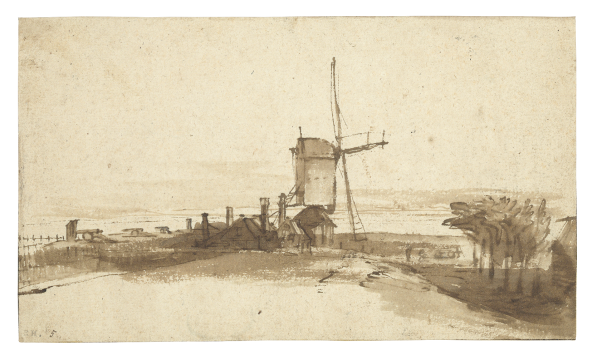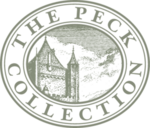Choose a background colour
Rembrandt van Rijn, Dutch, 1606-1669: Landscape with Canal and Boats, c. 1655
Pen in brown ink with brown wash on paper; framing lines in brown ink.
4 1⁄16 × 8 in. (10.3 × 20.3 cm)
Verso, in pen and brown ink, large calligraphic practice strokes (likely a seventeenth-century hand), showing through in places on the recto.
- Chain Lines:
- Vertical, 25 – 27 mm.
- Watermark:
- Foolscap with Seven Bells.
- Provenance:
Municipal Library, Mainz; Städtische Gemäldegalerie, Mainz, accessioned 1892, deaccessioned 1938; H. Gilhofer, Lucerne; Edwin Alfred Seasongood, 1876 – 1953, New York (Lugt 907a); dealer, Robert M. Light, Santa Barbara; British Rail Pension Fund, 1977; sale, Sotheby’s, New York, 29 January 1997, lot 49 (as attributed to Rembrandt); Sheldon and Leena Peck, Boston (Lugt 3847); gift to the Ackland Art Museum, inv. no. 2017.1.67.
- Literature/Exhibitions:
Frankfurt 1926, no. 368a; Stift und Feder 1930, no. 4, Supplement, pl. 93; Benesch 1935, 57; Benesch 1954 – 57, vol. 6, 373, no. 1349, fi g. 1583; Benesch 1973, vol. 6, 361, no. 1349, fi g. 1662; Austin 1981 – 82 (cat. unnumbered); Royalton-Kisch 1991, 16 – 18, fi g. 13 (as Rembrandt); F. Robinson in Chapel Hill, Ithaca & Worcester 1999 – 2001, 76 – 79, no. 22; F. Robinson in Peck 2003, 38 – 41, no. 9; Gnann 2021, 281 – 82, fi g. 260 (as Rembrandt); Bevers 2022, 259 – 60 (as Rembrandt).
- Ackland Catalogue:
- 2017.1.67
This seemingly straightforward depiction of a canal with boats is highly complex in its execution, showcasing Rembrandt’s exceptional skill as a draftsman. Firm and carefully controlled pen strokes indicate the solidity of the fence, boats, and edge of the bank, while dry and liquid brush strokes create mass in the foreground and reflections in the water. The distant horizon line, indicated by trees and buildings, is completed in pure wash. The faint swirls discernible in the sky are practice calligraphy strokes made on the reverse of the sheet, perhaps also made by the artist.
Between the early 1640s to mid 1650s, Rembrandt recorded the landscape during walks in the vicinity of Amsterdam, often sketching modest farms, fields, and canals as well as recognizable locations. The church spires and towers, although somewhat indistinct, suggest the Amsterdam skyline viewed from the southeast.
More so than in his paintings, Rembrandt revealed his distinct vision and evident passion for landscape subjects in his drawings and prints. He primarily did so in a fifteen-year period that spanned the early 1640s to the mid-1650s.1
Research into the topographical details in his body of landscapes, and close comparisons of those details with historical images of villages and buildings in and around Amsterdam, has provided a remarkably clear understanding of some of his most popular walking routes.2
Unsurprisingly, he would often leave through a gate on the east side of the city just down the street from his home in those years (the present-day Rembrandt House Museum) on the Breestraat, and walk along the Diemerdijk toward the village of Diemen, or along the Amstel River toward Ouderkerk. The spires of the churches and towers in this drawing, while too indistinct for exact identification, do give the impression of the Amsterdam skyline as it would have been observed on one of his walks along the Diemerdijk.3
This formerly marshy area now comprises the Zeeburg neighborhood of East Amsterdam, still somewhat preserved in natural form in the Flevopark.
Rembrandt’s pen work here is typically brilliant in its creative use of line and variety. He used a reed (or perhaps stiff quill) pen to lend a wooden quality to the planks of the boats using firm and carefully controlled strokes. Just as eye-catching are both the liquid and dry brushstrokes that miraculously convey line, motion, and texture, seen in the swiftly suggested rigging of the mast, and the subtle perturbations of the water just below its flat but reflective surface. It compares well to Rembrandt’s drawing, The Windmill “De Bok” on the Blauwhoofd Bulwark, with its lively sinuous lines and use of wash Fig. 41.1.4

Rembrandt, The Windmill “De Bok” on the Blauwhoofd Bulwark. Pen and brown ink with brown wash, 114 × 202 mm. Paris, Fondation Custodia, Collection Frits Lugt, inv. no. 5174.
Fondation Custodia, Collection Frits Lugt, Paris
The Peck drawing’s distinguishing feature is its use of pure wash to define the screen of trees and structures in the background, though a drawing in the Louvre reveals that Rembrandt would occasionally explore this approach to form Fig. 41.2.5

Rembrandt, River with Wooded Banks. Brush and brown ink, 136 × 186 mm. Paris, Musée du Louvre, inv. no. RF4709.
RMN-Grand Palais/Art Resource, NY
The different nature of the Louvre drawing is not surprising given Rembrandt’s well-known and tireless search for innovative methods and artistic procedures. This exploratory practice accounts for the great deal of variance in style in some of Rembrandt’s landscape drawings, which might on occasion employ a painterly abstraction of forms, or even be minimally impressionistic. Telling of this freedom to experiment is the fact that Rembrandt appears to have kept most of his landscape drawings to himself, which he stored in portfolios in his studio, according to the inventory taken in 1656.6
It is perhaps no accident, then, that the Peck landscape was drawn on a sheet cut from a larger piece of paper containing the practice calligraphy strokes still visible on the verso. His own album of calligraphy examples appears to have been stored on the shelf just next to one of his landscape albums.7
The attributions of Rembrandt’s landscape drawings have recently become a major subject of debate. In the 1950s, Otto Benesch catalogued about 250 landscapes in his complete catalogue of Rembrandt’s drawings.8
That total was cut almost in half by Peter Schatborn in his 2019 revision of Benesch’s corpus, which did not include the present sheet.9
In his 2021 book-length study of Rembrandt’s drawings, however, Achim Gnann returned nearly all of Schatborn’s removed drawings to Rembrandt’s oeuvre, including this one.10
Such a drastic difference of opinion is relatively unusual in drawings scholarship, and the debate will likely continue for some time, but as some scholars have already noted, the ultimate number of landscape drawings (and drawings in general) by Rembrandt’s hand is likely somewhat greater than that proposed by Schatborn.11
In his review of Schatborn’s corpus, Holm Bevers singled out the Peck landscape as one that is surely by Rembrandt’s hand and stated that any doubts are unfounded, a view that finds agreement here.12
Schatborn did not argue his specific doubts, but one cause for concern could have been the combination of pen work in the foreground with a pure wash background, which is indeed an unusual juxtaposition. This is not enough to militate against the essential virtuosity of this drawing, however. No hand among his pupils or followers emerges as a distinct possibility either. The closest perhaps would be Abraham van Dijck (1635 – 1680), who studied with Rembrandt in the early 1650s. His view, Buiten het Zaagmolenpoortje te Amsterdam (Outside the Sawmill Gate in Amsterdam), attempts similar pen work, boats-on-water reflections, and a distant background in wash, though without the same coherence of form or surety of hand Fig. Fig. 41.3.13

Abraham van Dijck, Outside the Sawmill Gate in Amsterdam, 1671. Pen and brush in brown ink, 125 × 290 mm. Amsterdam, Rijksmuseum, inv. no. R P-T-1884-A-304.
Rijksmuseum, Amsterdam
Rather than regarding the combination of foreground and background elements in the Peck drawing as something unusual or concerning, it is best considered, on the contrary, as a compelling and evocative addition to Rembrandt’s oeuvre. It is one, furthermore, that appears to have had an impact on followers like Van Dijck. They must have appreciated how Rembrandt, concerned with the perspectival handling of deep space in the background, used the canal to push the eye back into the distance, and ingeniously knitted the foreground and background elements together.
End Notes
For overviews of Rembrandt’s landscape drawings and prints, see especially Washington 1990; Amsterdam & Paris 1998 – 99; and Gnann 2021.
Reconstructing these routes based on topography was the primary aim of Amsterdam & Paris 1998-99, which built upon the earlier work by Frits Lugt in this regard; see Lugt 1915.
For Rembrandt’s walks along the Diemerdijk, see Amsterdam & Paris 1998 – 99, 206 – 44.
Schatborn & Hinterding 2019, 323, no. D496. See also Amsterdam & Paris, 1998 – 99, 202 – 04, fig. 4; Schatborn 2010, vol. 1, 52 – 54, vol. 2, 21, no. 11; and Gnann 2021, 282 – 83, fig. 261. Schatborn dates this drawing to circa 1645, while Gnann groups it with other landscapes from the early 1650s, and compares it specifically to the Peck Collection drawing.
Schatborn & Hinterding 2019, 399, no. D624. See also C. van Tuyll van Serooskerken in Paris 2006 – 07, 160 – 61, no. 56; and Gnann 2021, 289 – 90, fig. 269. Although remarkably experimental in style, the drawing’s attribution to Rembrandt rests on his handwritten notes on the verso for a stopping-out varnish for etching. A drawing related closely in style, though not included in Schatborn & Hinterding 2019, can be found in the Nelson-Atkins Museum of Art, Kansas City (inv. no. 60-20); see Benesch no. 1350; and Gnann 2021, 289, fig. 268 (who accepts both the Louvre and Nelson-Atkins drawings as by Rembrandt).
Desolate Boedelskamer, 25 – 26 July 1656; see Strauss & Van der Meulen, 348 – 88, doc. 1656/12, and for the landscape albums, inv. nos. 244 (fol. 35r), 256 (fol. 35v), and 259 (fol 35v).
Idem, inv. no. 260 (fol. 35v). A similar case of reuse of paper for one of the landscapes can be found in the Louvre study cited above (note 5) with his notes for an etching formula on the verso.
Benesch 1954 – 57 (reprinted 1973), passim.
Schatborn & Hinterding 2019, 302 – 99, nos. D479 – D624.
Gnann 2021; for the Peck drawing, see idem, 281 – 82, fig. 260.
See Gnann 2021, 10 – 11; and White 2022 (a review of Gnann 2021, finding the expanded oeuvre convincing). For countervailing arguments defending his corpus, see Schatborn 2022 (also a review of Gnann 2021).
Bevers 2022, 259 – 60.
De Witt 2020, 286 – 87, no. D50. With thanks to David de Witt for confirming that the Peck drawing is not by Van Dijck (email correspondence, 27 November 2018).
